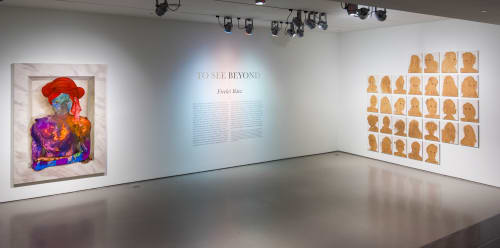Two exhibitions on display at the Contemporary Arts Center through Aug. 19 offer a pair of identity-probing perspectives from artists Alison Crocetta and Firelei Báez. This is the first solo museum exhibition for Crocetta, a hybrid performative and sculptural artist based in Columbus, Ohio, and the first Ohio exhibition for the Dominican Republic-born, Brooklyn-based Báez.
“I don’t want to over-determine why certain exhibitions are matched or paired with other ones,” says curator Steven Matijcio. While at first glance, the artists and their respective works feel very different, he recognized “a lot of shared ambition” between the two exhibitions.
A Circus of One, Crocetta’s exhibition, examines both costumes and tools from her past performative films. Matijcio says the collection of work showcases Crocetta’s analysis of the “performance of identity,” by utilizing the starting point and concept of circus and “over-the-top, indulgent experiences” to strip away from and explore the human framework of crafting an identity. The centerpiece is the premiere of her performative work A Circus of One (Act II), which has two more live shows at the museum — at 7 p.m. July 24 and 3 p.m. Aug. 18. Tickets can be reserved at contemporaryartscenter.org.
Translating past performative work into a reflective exhibition can be a challenge, but Crocetta views sculptural elements as both objects for her performances and collaborative tools to use within them. She refers to her movements as “actions,” imbuing the exhibition on the whole and individually with a serious, considered intentionality.
“One of the main themes of my entire career has always been my interest in the impact of performance or impact of human gesture on sculptural form,” she says. “How can sculptural form be transformed through human gesture? And also how does sculptural form extend, support, expand the possibilities for the body?”
Crocetta’s Bear in Mind (The Bill of Rights) is a 2006 video of an American Sign Language interpreter translating the Bill of Rights. You can listen to a recitation of the “gloss” — the literal transcription of the American Sign Language version — while watching the video. The recitation renders the Bill of Rights down to its most essential elements: “The Bill of Rights. First Amendment. Congress. They forbid your free expression. Can’t they. You have rights.” The distillation to essentials and the resulting contemplation of those elements is Crocetta’s point with this piece and, honestly, her entire body of work here.
From Surrender, a 2013 work wherein she interprets the concept of “play” by meditating on the occurrence of surrender in childhood games, we are presented with a soft white garment she wore during the original performance, as well as a white flag of surrender. Two images from the performance are also on display. The juxtaposition of freedom and surrender, which relinquishes resistance and therefore could also be considered a form of freedom, is powerful to consider.
Báez’s works are equally intentional, and her paintings create an amplified conversation around identity. Matijcio says she starts from a “more essentialist place,” pushing into a “hyperbolic” post-race realm, one where we’ve moved beyond the multitudes of damage caused by race and can examine the fluidity of identity.
It is especially fitting that her collection of work presented here is called To See Beyond. Much of it features pairs of penetrating eyes; if the body becomes fluid in her work, the eyes are steadfast portals, both literally and metaphorically, through which to view the work and the world it interprets.
The first paintings to confront the viewer are “for Marie-Louise Coidavid, exiled, keeper of order, Anacaona” and “Can I Pass? Introducing the Paper Bag to the Fan Test for the Month of June.” The former is a portrait of an exiled queen of Haiti, rendered in sumptuous purples and magentas that are reminiscent of religious iconography. The queen’s face is a deep-ocean-colored swirl, but her eyes are piercing.
“Can I Pass?” melds two tests of racial “passing” into a larger contemplation on self-identity. The first test is whether or not a person’s skin is lighter or darker than a paper bag, which translates to passing or not passing for being white and all its attendant implications. A similar Caribbean-born test uses hair blowing in a fan’s breeze, with denser hair resisting the wind and thinner hair moving easily.
The title of Báez’s exhibit — To See Beyond — comes from the name of the work Matijcio positioned as the “bookend” of the exhibition, an exuberantly colorful and gently amorphous portrait with a pair of eyes staring from the opposite end of the floor at “Can I Pass?” It feels almost ethereal when compared to the sobering “Can I Pass?,” a counterbalance for the many ways we can perceive ourselves.

